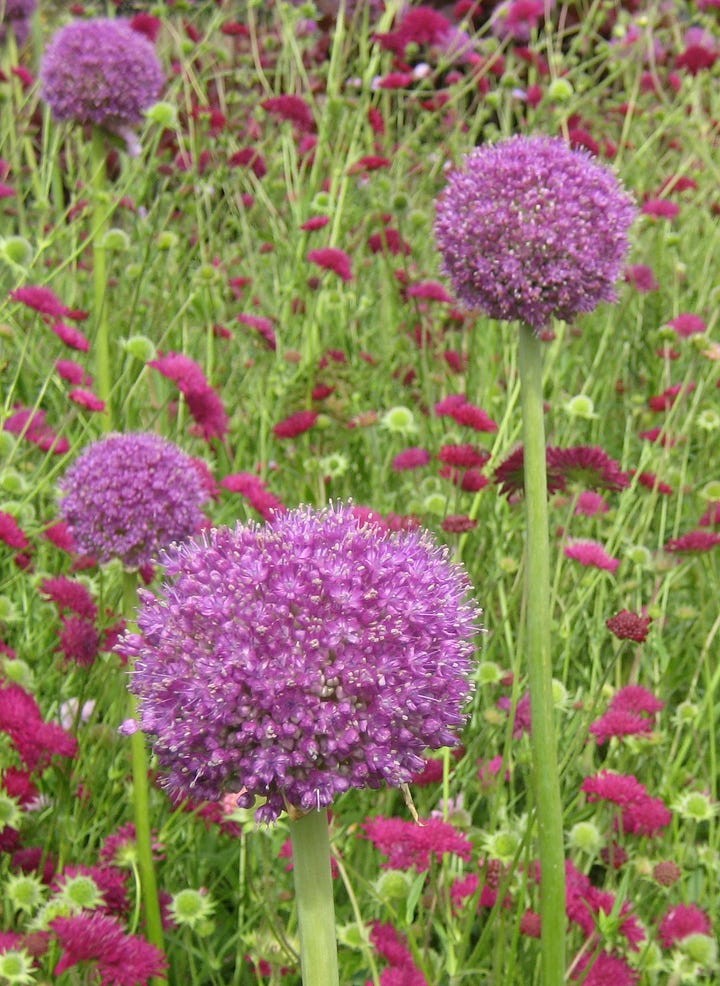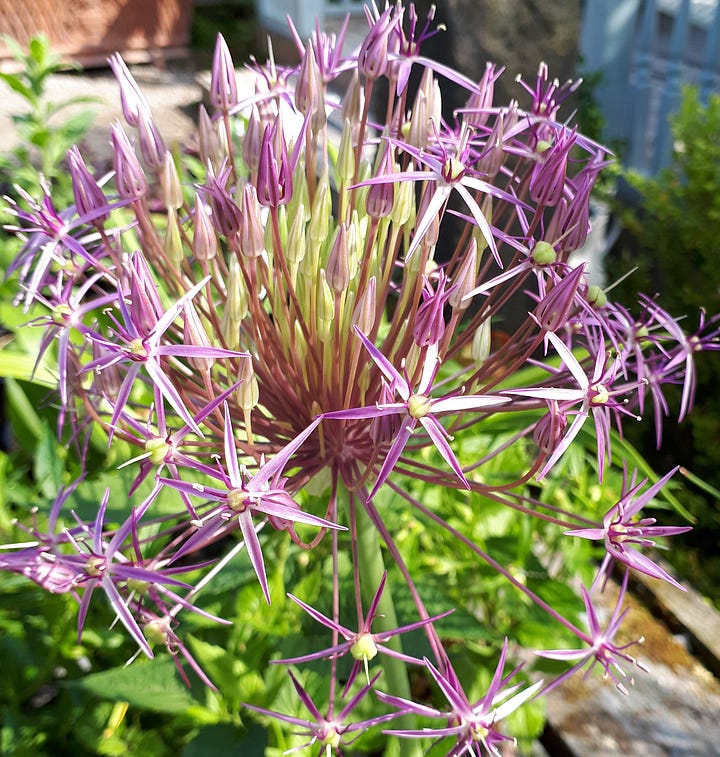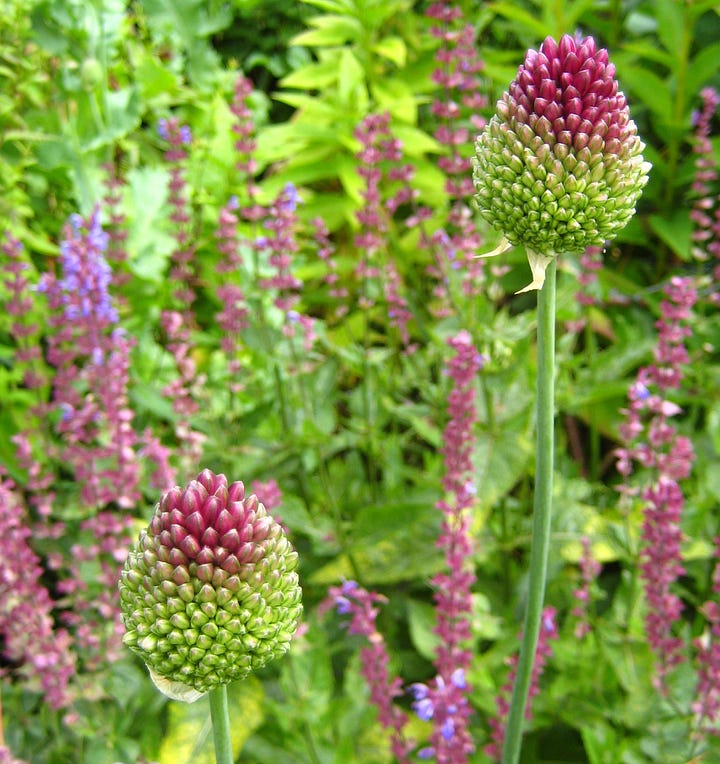May - Episode 1
Welcome to the first of my offerings for May. (The next batch will be posted on the 17th.)
There’s no stopping May: there is new growth everywhere and gardening jobs are building up.
So what’s coming up this time?
We have:
· my Pollinator Plant of the Month
· we’re taking a look at some ‘May’ plants
· the spotlight is on Lilac
· and a poem
So without further ado, here’s my Pollinator Plant of the Month - Allium
The Chelsea Flower Show is coming up and I will wager that an allium will appear one in form or another in a good number of gardens.
But why? What’s so special about them? I don’t have the definitive answer, but I think there are a couple of things that make them popular.
First is the colour. You can find the majority of alliums in the purple part of the colour wheel (there are other colours, of course, but the most popular varieties appear to be the purple ones). Purple is regal and luxurious; it stands out, yet is easy on the eye; it goes with just about every other colour – imagine purple and apricot, purple and lime green, purple and burgundy: they all work well.
Second is the form. The majority are a pleasing spherical shape. They’re curved and non-angular – an attractive shape to look at.
Third is the size. For the amount of vertical impact their drumstick heads make, they take up very little ground space. You can slot them in just about anywhere, knowing that they won’t elbow anything else out of the way.
Fourth is their flowering time. A number of them provide interest in that in-between time twixt spring and summer, whilst others flower just that little bit later, providing on-going interest in the border before the main thrust of blooms take over during the halcyon days of summer.
Fifth is the way they can be used in a planting design. If you’re looking for a something that will give you movement, repetition or a punctuation mark in a design, then look no further. Even small groups will make a visual statement: large swathes will give you the ‘wow’ factor and then some. Use them in a modest area of planting, to a huge prairie-type scheme – they won’t look out of place in any scenario.
So you can see why they’re so popular at Chelsea!
They’re also very popular with bees – another reason the plant them.




Let’s have a look at some of these wonder-flowers, now. Probably the most well-known, and most widely planted, is Allium hollandicum ‘Purple Sensation’ (top left). It grows to about 90cm in height, so is one of the taller varieties. It likes sun and well-drained soil, so when you plant it in the autumn, choose your spot carefully.
Allium cristophii (top right) is paler in colour, and slightly smaller in stature, than A. ‘Purple Sensation’ but what it lacks in height it makes up for with the size of the flower head – up to 20cm!
For a sheer firework display-like show you can’t beat A. schubertii – its pale pink flowerheads simply explode atop 60cm stems.
Paler still is A. ampeloprasum (bottom left), but it outdoes even A. ‘Purple Sensation’ in height – up to 1m.
One of the smallest flowerheads belongs to A. sphaerocephalon (bottom right). It’s also one of the latest flowering so is a real treat when the others have long given up the ghost. The colour is intriguing: starting green in bud, the full-blown flowers are a deep burgundy, almost blackberry colour – lovely.
I’ve been focussing on ornamental Allium, but let’s not forget that the Allium family also includes edible varieties. Leeks, garlic, and all kinds of onions fall under the Allium umbrella: here’s just two of them that look good enough to eat.
First is Allium ursinum (below left), known as wild garlic or ramsons. (By the by, the name Ramsbottom has nothing to do with rear-ends of male sheep – it means the valley bottom where ramsons grow!) A. ursinum grow in deciduous woodland areas where they produce both leaf and flower before the tree canopy shades the ground below. They will need similar conditions if you want to grow them in the garden - but be warned, they’ll run amok if they get the chance. You can eat both leaf and flower – they have, as the common name suggests, a flavour of garlic.


The second is Allium schoenoprasum (above right), or chives. These are invaluable in the herb garden, providing leaves as well as flowers for all kinds of culinary delights. I love taking the flowerheads apart and using the individual flowers in a salad – they give a little pop of oniony flavour and a dash of colour to boot. They need moisture-retentive but free-draining soil in a sunny position, although they will cope with a bit of shade.
And to finish with here is an Allium from my garden which certainly wouldn’t make it into any show garden. It developed like this, with two ‘extra’ inflorescences sprouting from the main globe – pointed out by the red arrows.
I’ve tried to find out what may have caused it and the nearest explanations I can find is that the bulb contained a virus, or that the warm spring resulted in a mutation in the growth of the inflorescence. If anyone can shed any more light on it, please get in touch.
Well, here we are in May.
It seems to me ‘may’ has lots of meanings, apart from its use as a modal verb and the name of the fifth month, with quite a few linked to plants, so let’s spend a few otherwise idle moments looking at a couple.
First, there’s its use as the common name for Crataegus monogyna – May Blossom, May Flower, or simply May (but Crataegus is also called Hawthorn, Quickthorn or Whitethorn just to confuse things). This deciduous tree must be one of the least fussy and most versatile trees that we have. It will grow in just about any location, including coastal and exposed areas, in just about any soil as long as it’s not waterlogged, and can cope with part shade: it also makes a beautifully shaped tree (up to about 6m, so it needs a bit of space), or it can be grown as a hedge.
There’s an old saying 'Ne'er cast a clout till May be out', which means that you shouldn’t go without your outdoor clothing until May is over. Some people regard this as being the month of May, but others think it refers to the flower of the Crataegus which is in blossom in mid- to late-spring.
Apparently, May blossom was also used to garland the May Queen, although I can’t help but think it would be a bit too prickly. It’s also been surmised that the old rhyme ‘Here we go gathering nuts in May’ is a corruption of ‘Here we go gathering knots of may’ meaning collecting bunches, or ‘knots’, of may blossom for the celebrations. Which sort of makes sense because what nuts can be harvested so early in the season?
And then there’s the line from Shakespeare’s Sonnet 18: ‘Rough winds do shake the darling buds of May’. Crataegus was certainly known as the Maybush in Shakespeare’s time, so it would seem that the darling buds are indeed those of the Crataegus. However, I do remember being told once that the line refers to a variety of apple (or possibly other fruit), called ‘Darling’ that flowers in the month of May. I’ve tried and tried to find a reference to it but without joy. If anyone knows anything about it, please get in touch!
Then we have the May Lily, Convallaria majalis, also known as Lily of the Valley: both common names make sense if we look at the Latin: Convallis means the valley; majalis refers to the month of May – so we have a flower that grows in the valley and flowers in May.
Each month has its own flower assigned to it, so not surprisingly the flower for May is the May Lily. There are various myths and legends whirling around it: in the language of flowers it means ‘return of happiness’; it also symbolises chastity, purity, happiness and luck so it has long been included in many a bride’s bouquet (including HRH The Princess of Wales); plant it in your garden and you will attract fairies because they will use its bells as cups to drink from; and it’s also reputed to protect gardens from evil spirits. So there you go!
If you do want to plant it in your garden make sure you have the right conditions, namely moist, fertile, humus-rich moist soil in full or partial shade: if it likes its location it will form a goodly colony.
The 1st May has traditionally been regarded as a time of celebration and festivity to welcome the coming of Spring, with dancing around a pole, Morris dancing, and choosing a May Queen to head up the festivities. Which leads me nicely to another ‘May’ flower – Rosa ‘May Queen’. Being introduced in 1898 it hasn’t got the same long pedigree as the festivities, but this rambling rose certainly deserves its name. It’s fragrant with sprays of gorgeous, double, lilac-pink blooms which appear later in May and throughout the summer. Lovely.
And last, there’s Geranium sylvaticum ‘Mayflower’. As we saw with Convallaria, the Latin name gives us a clue about the plant, this time it’s the sylvaticum bit. This means ‘of the wood’, which tells us about the conditions the species was originally found in, so if we give it similar a similar environment in the garden - moist soil is best but it will grow in any, moderately fertile soil; it prefers partial shade or sun but will tolerate shade - it will be a happy chappy.
This chappy is not modest or demure, however; it will grow to about 70cm in height with a spread of about 50cm, so it needs a bit of space. And does it flower in May? Well, I took the photo on 13th May a few years ago so it does live up to its name of Mayflower.
We’re celebrating the anniversary of VE day in five days’ time. I am of a generation whose parents served in the Second World War – my Dad was a Sergeant in the 12th Parachute Battalion and my Mum served in the ATS (Auxilliary Territorial Service). Neither of them spoke much about the War but I do remember my Mum humming a tune which she said reminded her of how lucky they were to have survived those dark days. And the tune? It was ‘We’ll Gather Lilacs’, written by Ivor Novello for the stage show Perchance to Dream which was performed at the Hippodrome Theatre in London from 1945 to 1948. Part of the chorus goes like this:
‘We’ll gather lilacs in the spring again / And walk together down an English lane / Until our hearts have learned to sing again / When you come home once more.’
And, of course, we had a lilac bush in the garden. Although it was only in bloom for a relatively short period of time, its conical panicles of fragrant flowers would fill practically the whole garden with delicious scent. The rest of the year it formed an almost non-descript six-foot (1.8m) green backdrop to the perennials that performed in front of it throughout the seasons.
The bush that Mum grew was undoubtedly the common lilac (Syringa vulgaris). It grew particularly well in our south-west facing garden with its chalky soil because lilac does best in a sunny spot with alkaline, free-draining conditions. Mum would give it a bit a trim soon after it flowered if she thought it was getting out of hand; otherwise, apart from giving it a mulch of home-made compost each spring, she just left it to its own devices.
Although Mum and nearly all our neighbours had a lilac in the front garden back then, it has fallen in and out of fashion since its introduction to the UK in the 1500s from South Eastern Europe. It became really popular in the late 19th Century, however, when a certain Frenchman, M. Lemoine, got his hands on it and introduced some 150 cultivars, some of which are still with us today. S. vulgaris ‘Madame Lemoine’ for example, which produces pure white double flowers is available from no less than 42 nurseries listed in the RHS Plant Finder.
You’ll also find that the mauve-pink double flowered S. vulgaris ‘Belle de Nancy’, and the pale pink flowered ‘Michel Buchner’ are widely available too. If you fancy another established variety, try the purple flowered ‘Ruhm von Horstenstein’, or if you would rather try out a relatively recent introduction there is the double, blue-lilac variety ‘Nadezhda’ from Russia.
Just a quick word about whether lilac is any good for pollinators, and bees in particular. I have read a few comments about its attractiveness to pollinators but despite the heavenly fragrance I have yet to see multitudes of our buzzy friends make a bee-line for it. It’s possible that the corolla tube is too narrow and long for a bee’s proboscis to reach any nectar pooling at the bottom of it, in which case it is more suited to butterflies. If you have a lilac in your garden, I’d be interested to know what insects visit it – please let me know via the comments.
In the meantime, I’ll take over where Mum left off and hum a chorus of ‘We’ll Gather Lilacs’.
Occasionally I include some thoughts about a work of art or a piece of music; sometimes a book review. This time, though, I’m looking at a poem from one of my favourite poets, Edward Thomas (1878 – 1917). Sometimes known as a War Poet, I like to think of him as a Nature Poet because all of his poems are grounded to some extent in Nature. And the one I’ve chosen is no exception. I’ve chosen it because my piece above about lilac and its connection to the dark days of World War 2, and that we’re in May, reminded me of Thomas’s poem called The Cherry Trees . It’s a poignant poem, reminding us very subtly of the futility of war:
I’ll leave it there.
Picture credits:
All my own: © Maureen Little - except cherry blossom background: Pixabay
Poem: Edward Thomas, ‘The Cherry Trees’, from Edward Thomas: Poems selected by Matthew Hollis, 2016, Faber & Faber Ltd. London









